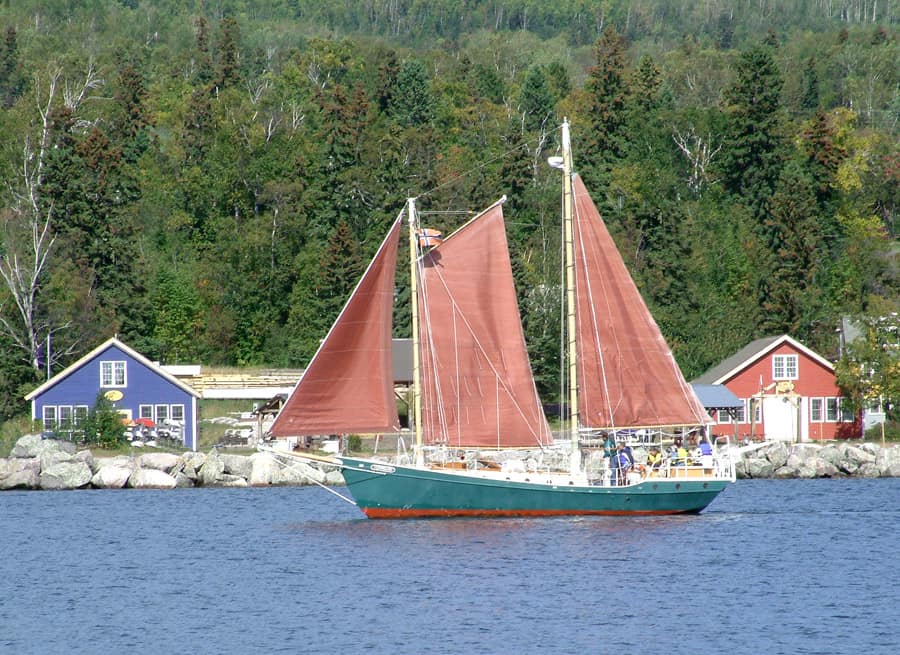
By Charlie Mahler, Wilderness News Contributor
This month, students in Bill Lane’s saw-whet and boreal owling class at North House Folk School in Grand Marais won’t just be tromping through the wet Minnesota woods hoping to hear, see, and checklist owls like more typical birders. In the spirit of the hands-on ethic of the school, and in just the sort of synergistic relationship that North House seems to foster between the landscape where it is set and the traditional northern crafts it has taught to so many students in the school’s nearly 10 years of existence, Lane’s students will connect themselves to owls and owls’ landscape through their hands, as well as their eyes and ears.
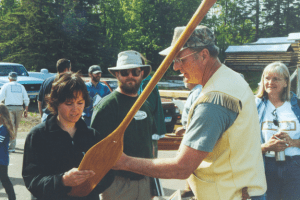
Students in the one-day class will build nest boxes during the class’s daytime hours, learn the essentials of the owls’ breeding and nesting habits, and then, in the evening, venture into the forest to observe owl courtship and nesting behavior at already-established nest-boxes in the forest.
“Northern ecology that incorporates your hands, your heart, your mind,” North House Program Director Scott Pollack hoots about the class. “How about a ‘Habitat for Non-Humanity’ project! Why not build nesting boxes and get into the field, hang them and observe their behavior all at the same time?”
Lane’s class is just a more direct example of the connection North House students often make between themselves and the beloved Quetico-Superior landscape. North House classes in, say, shelter building, canoe and paddle-making, basketry, or tool-making can all serve to dissolve the barriers between a lover of the northwoods and the woods themselves. Or, for that matter, develop a greater understanding for the big water that laps against North House’s Lake Superior shore location. Just as the traditional craft classes offer new realizations about how the land behind the school works its magic, learning to sail Superior on North House’s 50-foot gaff-rigged schooner Hjørdis opens an understanding of the moods of the wind and water of Gitchi Gummi like few others.
“For me, life is enriched when I broaden and deepen my understanding of the places I experience,” North House Executive Director Greg Wright offers, “and I think this is a feeling shared by many North House students. Clearly, traveling by canoe is an enriching experience for many people. Would making the same trip using a paddle you hand-crafted, or better yet a canoe you built, deepen the experience? Each journey – of traveling, of building – impacts and affirms the other.”
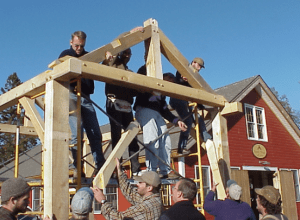
Call it portaging to a new pool of understanding.
The Mission
Nikolaj Frederik Severin Grundtvig probably didn’t think of folk schools in exactly this way in early 1800s Denmark. Grundtvig however, a poet, philosopher and theologian and the father of the folk school movement, did see the need for an educational model separate from the elitist, Latin-based formal education of the time. Social and political changes taking place then prompted a need for an educational form to met the needs of the newly democratized and increasingly nationalistic population of the Scandinavian countries.
By the late 1800s folk schooling was popular and schools that were originally developed by socially-conscious university educators soon became the domain of grassroots groups like local farmers or labor unions. The movement is credited by some as fostering the first rural democratic civilization in Denmark.
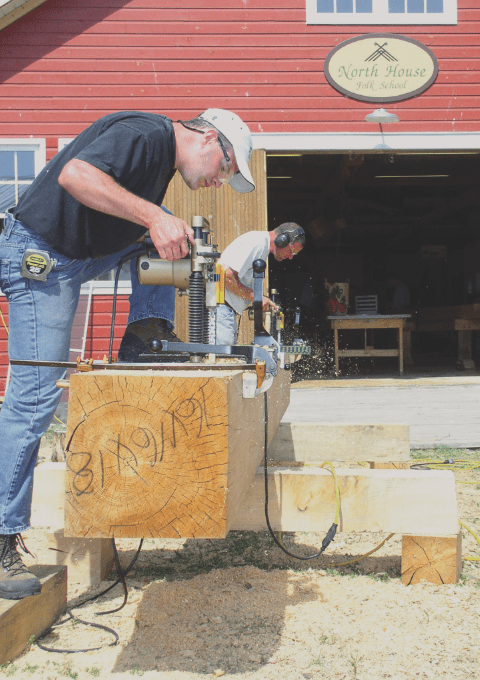
Centuries later in northern Minnesota, Mark Hansen – like Grundtvig, the son of a pastor – would, along with others in the community, see the need for a folk school-style learning in his culture.
“I was a really poor student because I was so bored with what was going on,” Hansen recalls from his youth. “You’ve got people that only teach a certain way in public schools. They were good at sitting in rows and learning rote information and puking it out on a piece of paper, and I was completely shut down on that.”
Hansen, a boat-builder and jack-of-all-skills with wood, was drawn to the folk school ideal because he nonetheless loved to learn and liked to learn from people who build things. “They think like I do,” Hansen continued. “I ended up going to
college and graduate school for some reason –
I wasn’t dumb – I just know that I stared out the window and thought about what I was going to build when I got home.”
Informed by that experience, Hansen gathered like-minded people around his ideas of an inclusive, non-competitive, learn-for-the-sake-of-learning educational setting. Wright names local bead and fiber-artist Jo Wood, wood-block printer Betsy Bowen, and artist and wood-fire bread-maker Toni Mason as part of the circle of people critical to the establishment of the school. Wright attributes rise of North House to that critical mass of talented artists and crafts-folk in the Grand Marais area and the strong “commitment to humanity” embedded in the community.
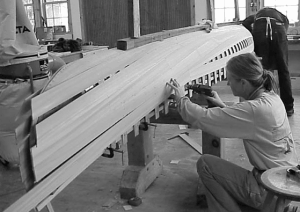
Since its inception in 1997, the school has grown in its mission “to enrich lives and build community through the teaching of traditional northern crafts.” The non-profit institution supports itself by tuition, memberships, and foundation grants. The campus which was established on the Lake Superior shore at the foot of the old Gunflint Trail in former Forest Service warehouses is quickly bursting its seams. Last year the school offered some 300 courses, taught by 90 different regional artisans, educating some 8,500 students in classes lasting anywhere from two hours to two weeks. The school offers courses to the general public through its catalog as well as custom courses for primary school, secondary school, and college groups.
“The goal for North House isn’t to grow and get big; it’s to achieve our mission,” Wright notes. “We’re not going to do that by becoming the Wal-Mart of folk schools. That’s not what it’s about. That said, our mission calls us to touch people’s lives. And this campus is going to be too small, over time.”
Current course listings include courses in basketry, boatbuilding, clothing and jewelry, fiber arts, foodways, knitting, music, northern ecology, outdoor skills and travel, painting and photography, sailing, shelter, sustainable living, timber framing, tool-making, traditional crafts, woodcarving, and woodworking.
Special Events
Regularly scheduled special events are instrumental in drawing first-timers to the school and to offer the impetus to bring regulars back to campus. Annual events at North House include the Winterer’s Gathering and Arctic Film Festival each November and the Wooden Boat Show each June. The school also partners with local businesses and organizations for special programs. Last winter, North House and the Sivertson Gallery of Grand Marais hosted Inuit carver Ohito Ashoona who taught a soapstone carving class at the school. North House instructor John Zasada’s Celebrating Birch exhibit at Grand Marais’ Johnson Heritage Post was
celebrated with a weekend-long “opening” in February. The Wooden Boat Show this year, scheduled for June 16-18, will feature a wooden boat display, a “Boats-to-Tools” auction, films, seminars, workshops, and demonstrations. There’s also a summer solstice puppetry pageant.
Featured guests at the event this year are Garrett and Alexandra Conover. Like Bill Lane with his owling class, the Conovers personify the connection between traditional skills and crafts and the natural landscape that helps define North House. The Maine couple leads wilderness trips – in all seasons – traveling by traditional means and with traditionally made equipment and clothing.
“Engagement with the natural world with a small community of fellow travellers balances the estrangement fostered by our usual surroundings,” Garrett Conover has said. “Traditional trips upon the waterways allow for grace, thoughtfulness, and a pace that favors observation and connection.”
The same ethic that builds nesting boxes to know owls better and travels traditionally through nature to better connect with it, makes North House Folk School one with its human and ecological community.
For more information on the North House Folk School go to: www.northhouse.org or via US mail at North House Folk School, P.O. Box 759, Grand Marais, MN 55604-0759.

